Targeting Kubernetes Cluster With Gremlin Chaos Test
Join the DZone community and get the full member experience.
Join For FreeGremlin is a leading software company focusing on chaos-test in the market. It also has a tool similar to Chaos Monkey which belongs to Netflix, but is more customized to test the system with random loads or scheduled shutdowns. In the article below, we will be testing a simple Kubernetes cluster running on EKS with Chaos Test.
Why Is Chaos Testing Important?
Chaos Engineering is used to improve system resilience. Gremlin’s “Failure as a Service” helps to find weaknesses in the system before problems occur.
Overview
To successfully experience Chaos Engineering with Gremlin, we have two requirements: a running EKS cluster and two applications deployed to EKS. This tutorial helps to produce the requirements and create a scenario to "simulate an attack with Gremlin".
- Step 1 - Prepare Cloud9 IDE
- Step 2 - Create an EKS cluster using eksctl
- Step 3 - Deploy Kubernetes Dashboard
- Step 4 - Install Gremlin using Helm
- Step 5 - Deploy a Microservice Demo Application
- Step 6 - Run a Shutdown Container Attack using Gremlin
Prerequsities
1. An AWS account
2. A Gremlin account which can be registered from here
Step 1 - Prepare Cloud9 IDE
Firstly, let's start to create the Cloud9 environment. Login to your AWS account and navigate Cloud9 to service page. Click on Get Started and type the name with anything, in this example we have chosen chaous gremlin. Keep all default settings as they are stated since it is needed only to reach EKS resources.
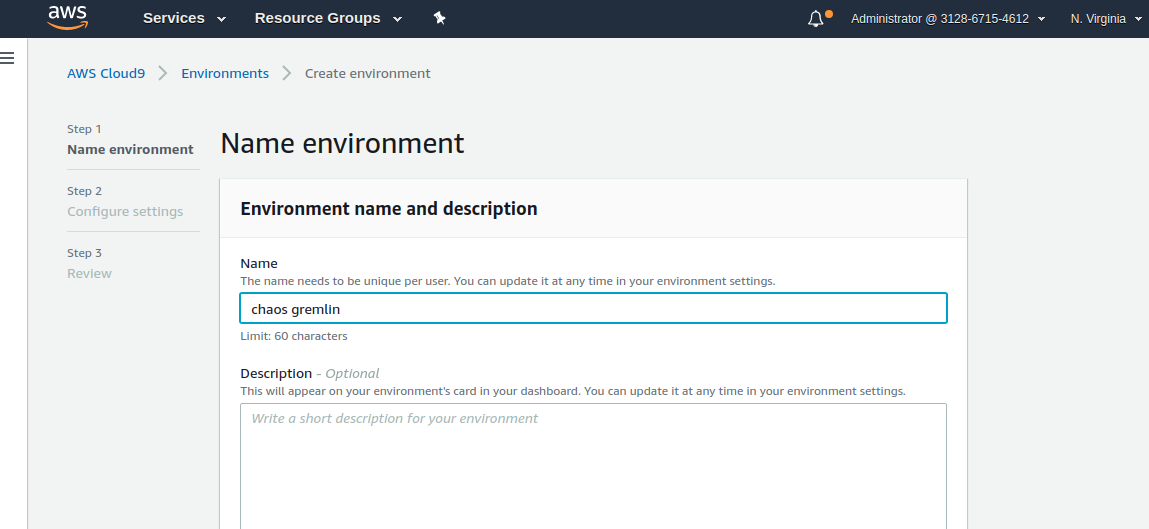
Wait for a while for the new console to build. Then close all terminals to open a new one.
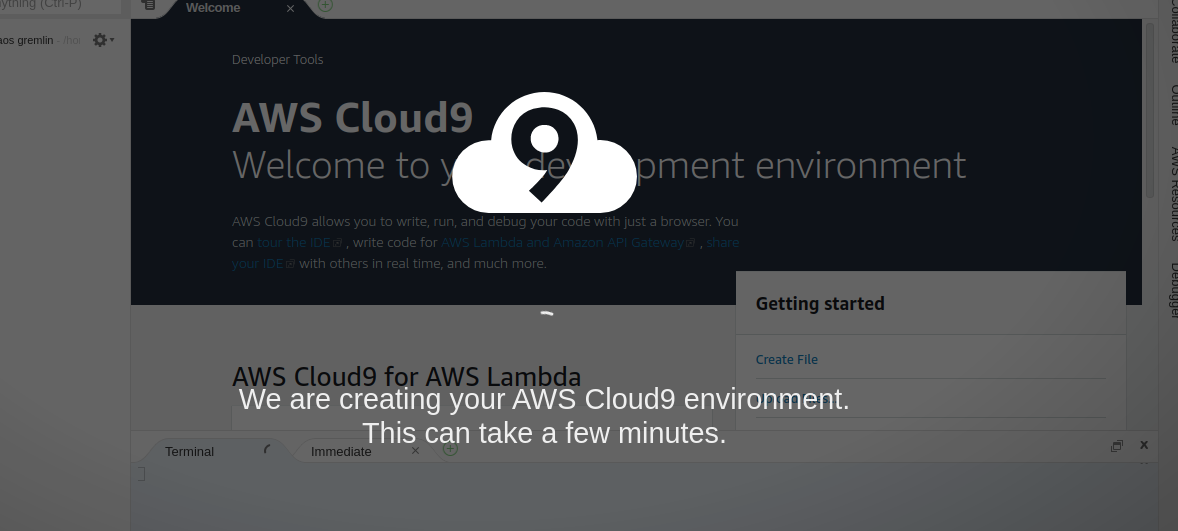
To start creating the cluster, firstly check whether AWS CLI is installed or not with the command below:
xxxxxxxxxx
Administrator:~/environment $ aws --version
aws-cli/1.17.5 Python/2.7.16 Linux/4.14.158-101.185.amzn1.x86_64 botocore/1.14.5
Administrator:~/environment $
Step 2 - Creating an EKS cluster using eksctl
We will use eksctl to create our EKS clusters.
xxxxxxxxxx
curl --silent --location "https://github.com/weaveworks/eksctl/releases/download/latest_release/eksctl_$(uname -s)_amd64.tar.gz" | tar xz -C /tmp
sudo mv -v /tmp/eksctl /usr/local/bin
Making eksctl executable
xxxxxxxxxx
Administrator:~/environment $ sudo chmod +x /usr/local/bin/eksctl
Administrator:~/environment $
Confirming whether the eksctl command works:
xxxxxxxxxx
Administrator:~ $ eksctl version
[ℹ] version.Info{BuiltAt:"", GitCommit:"", GitTag:"0.13.0"}
Administrator:~ $
Below we are creating the cluster named gremlin-eksctl with three EC2 nodes. Just a word of warning - EKS can cost a lot so please do not forget to delete your resources after you have done with your failure test.
xxxxxxxxxx
eksctl create cluster --name=gremlin-eksctll --nodes=3 --managed --alb-ingress-access --region=${AWS_REGION}
It might take around 15-30 minutes to get ready which you can cluster on the EKS service page.
Quit Tip - Fee of EKS is 0,20$/h and fee of EC2 with a m5.large instance type that EKS runs on is 0.096$/h. Estimation of total cost per day will be around 11-12$.
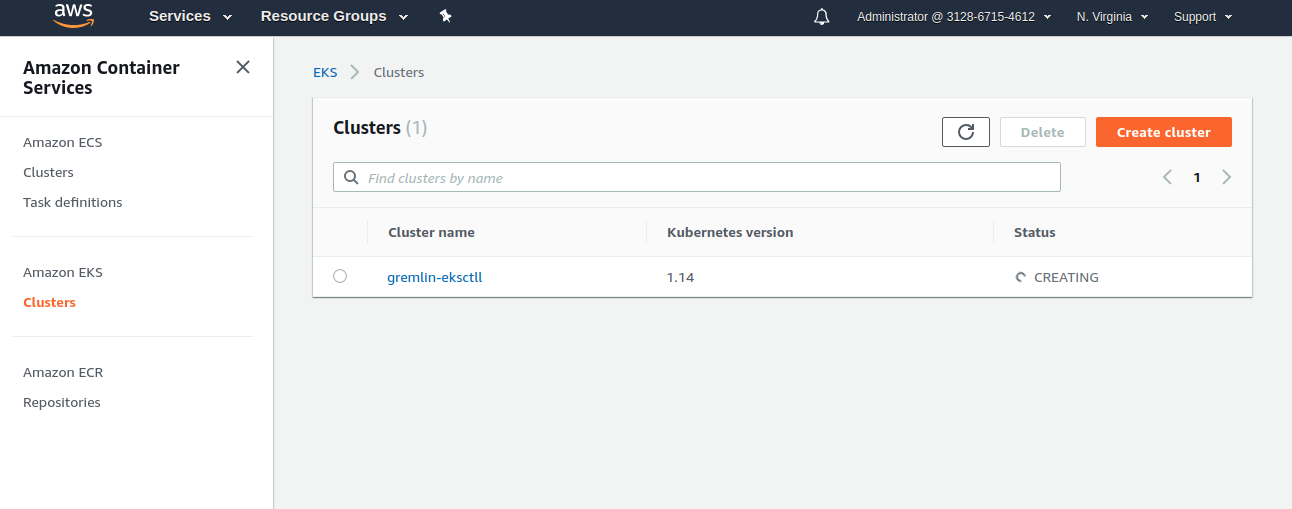
Checking the cluster whether it is working and getting its status. As expected, there is only one cluster created.
xxxxxxxxxx
Administrator:~/environment $ eksctl get clusters
NAME REGION
gremlin-eksctl us-east-1 Administrator:~/environment $
Updating the kubeconfig file by giving the cluster name and region via AWS CLI tool.
xxxxxxxxxx
Administrator:~/environment $ sudo aws eks --region us-east-1 update-kubeconfig --name gremlin-eksctl
Updated context arn:aws:eks:us-east-1:312867154612:cluster/gremlin-eksctl in /root/.kube/config
Administrator:~/environment $
On checking we see 3 nodes in the cluster. Two of them are worker-nodes while the third is cluster management master-node.
xxxxxxxxxx
Administrator:~/environment $ kubectl get nodes
NAME STATUS ROLES AGE VERSION
ip-192-168-14-59.ec2.internal Ready 59m v1.14.7-eks-1861c5
ip-192-168-33-12.ec2.internal Ready 58m v1.14.7-eks-1861c5
ip-192-168-49-55.ec2.internal Ready 58m v1.14.7-eks-1861c5
Administrator:~/environment $
Step 3 - Deploying Kubernetes Dashboard
Next we would deploy the Kubernetes dashboard to Kubernetes cluster by using Heapster and InfluxDB. These two tools will help our sample application to be shown in the dashboard. We will start with deploying our Kubernetes dashboard as the first step.
Heapster
Heapster is a performance monitoring and metrics collection system compatible with Kubernetes (versions 1.0.6 and above). It allows for the collection of not only performance metrics about your workloads, pods, and containers, but also events and other signals generated by your cluster. The great thing about Heapster is that it is fully open source as part of the Kubernetes project, and supports a multitude of backends for persisting the data, including but not limited to, Influxdb, Elasticsearch, and Graphite.
InfluxDB
InfluxDB is a time series database designed to handle high volume of writing and query loads.
- Deploying the Kubernetes Dashboard to your EKS cluster:
xxxxxxxxxx
Administrator:~/environment $ kubectl apply -f https://raw.githubusercontent.com/kubernetes/dashboard/v1.10.1/src/deploy/recommended/kubernetes-dashboard.yaml
secret/kubernetes-dashboard-certs created
serviceaccount/kubernetes-dashboard created
role.rbac.authorization.k8s.io/kubernetes-dashboard-minimal created
rolebinding.rbac.authorization.k8s.io/kubernetes-dashboard-minimal created
deployment.apps/kubernetes-dashboard created
service/kubernetes-dashboard created
Administrator:~/environment $
xxxxxxxxxx
Administrator:~/environment $ kubectl proxy --port=8080 --address='0.0.0.0' --disable-filter=true & [1] 336
Administrator:~/environment $ W0125 10:28:19.746961 336 proxy.go:140] Request filter disabled, your proxy is vulnerable to XSRF attacks, please be cautious Starting to serve on [::]:8080
Administrator:~/environment $
Deploying Heapster:
xxxxxxxxxx
Administrator:~/environment $ kubectl apply -f https://raw.githubusercontent.com/kubernetes/heapster/master/deploy/kube-config/influxdb/heapster.yaml serviceaccount/heapster created deployment.extensions/heapster created service/heapster created Administrator:~/environment $
Deploying InfluxDB:
xxxxxxxxxx
Administrator:~/environment $ kubectl apply -f https://raw.githubusercontent.com/kubernetes/heapster/master/deploy/kube-config/influxdb/influxdb.yaml
deployment.extensions/monitoring-influxdb created
service/monitoring-influxdb created
Administrator:~/environment $
Creating Heapster cluster role binding for the Dashboard.
xxxxxxxxxx
Administrator:~/environment $ kubectl apply -f https://raw.githubusercontent.com/kubernetes/heapster/master/deploy/kube-config/rbac/heapster-rbac.yaml
clusterrolebinding.rbac.authorization.k8s.io/heapster created
Administrator:~/environment $
The next step is to create an eks-admin service account. It will let you connect to the Kubernetes Dashboard with admin permissions.
To authenticate and use the Kubernetes Dashboard:
xxxxxxxxxx
Administrator:~/environment $ kubectl apply -f https://raw.githubusercontent.com/tammybutow/eks-aws/master/eks-admin-service-account.yaml serviceaccount/eks-admin created
clusterrolebinding.rbac.authorization.k8s.io/eks-admin created
Administrator:~/environment $
To access the Kubernetes Dashboard:
- In your Cloud9 environment, click Tools > Preview > Preview Running Application to open the Dashboard URL.
- Append the following to the end of the URL:
xxxxxxxxxx
/api/v1/namespaces/kube-system/services/https:kubernetes-dashboard:/proxy/
xxxxxxxxxx
aws eks get-token --cluster-name gremlin-eksctl | jq -r '.status.token'
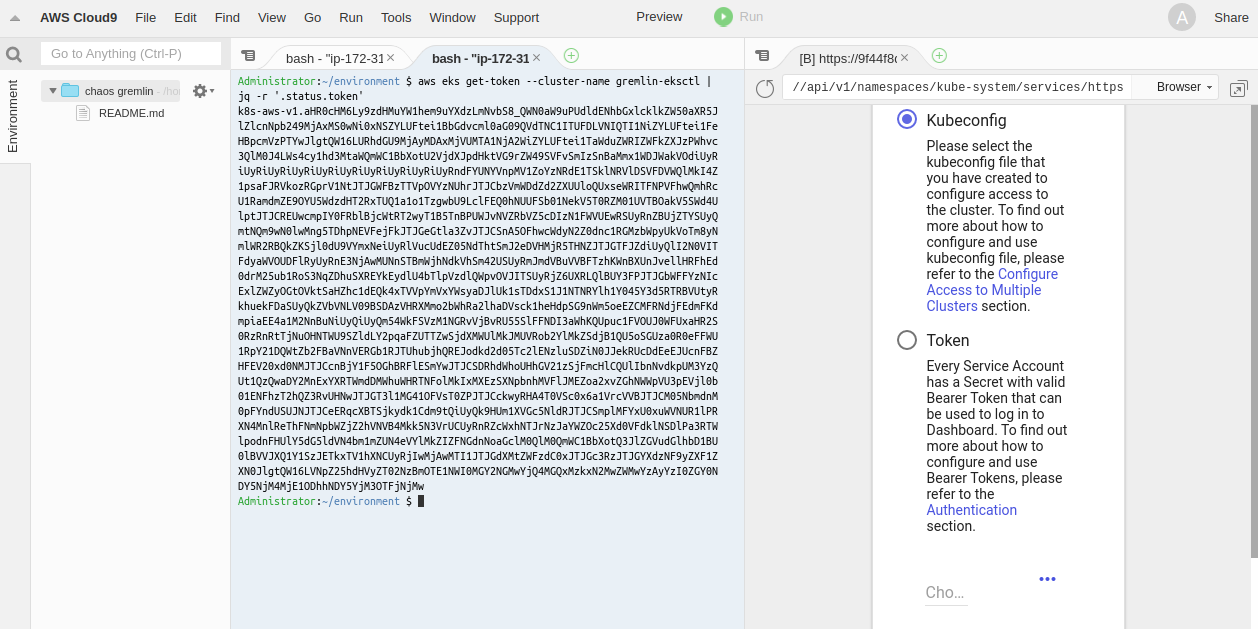
Select Token and then copy the output of the command above and paste it to the text field as shown below: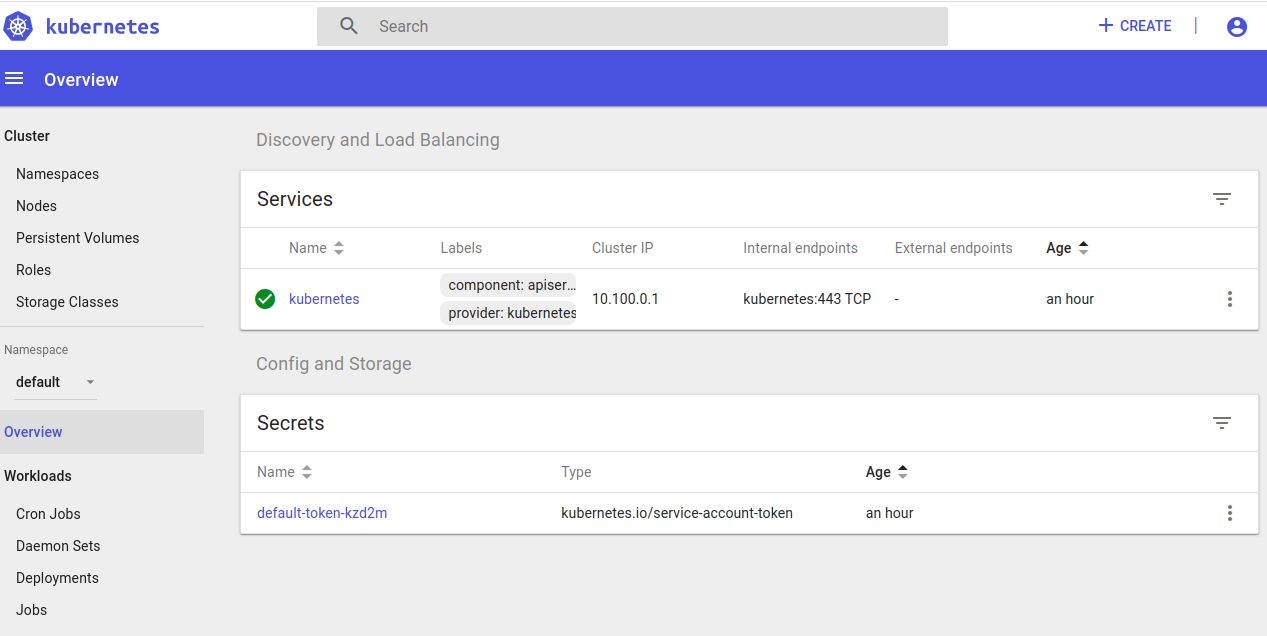
Step 4 - Installing Gremlin using Helm
Download your Gremlin certificates:
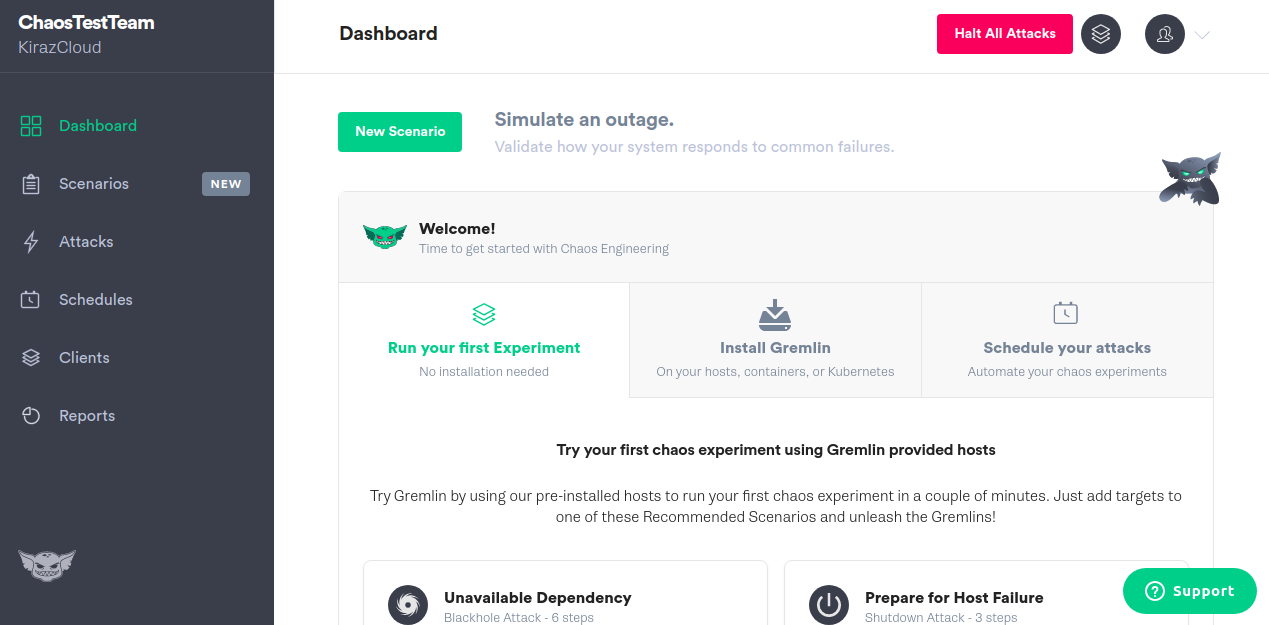
Start by signing-in to your Gremlin account. If you don't have one, create an account here. Navigate to Team Settings and click on your Team. Click the Download button to download and save certificates to your local drive. Please note that the downloaded certificate.zip contains both a public-key certificate and a matching private key.
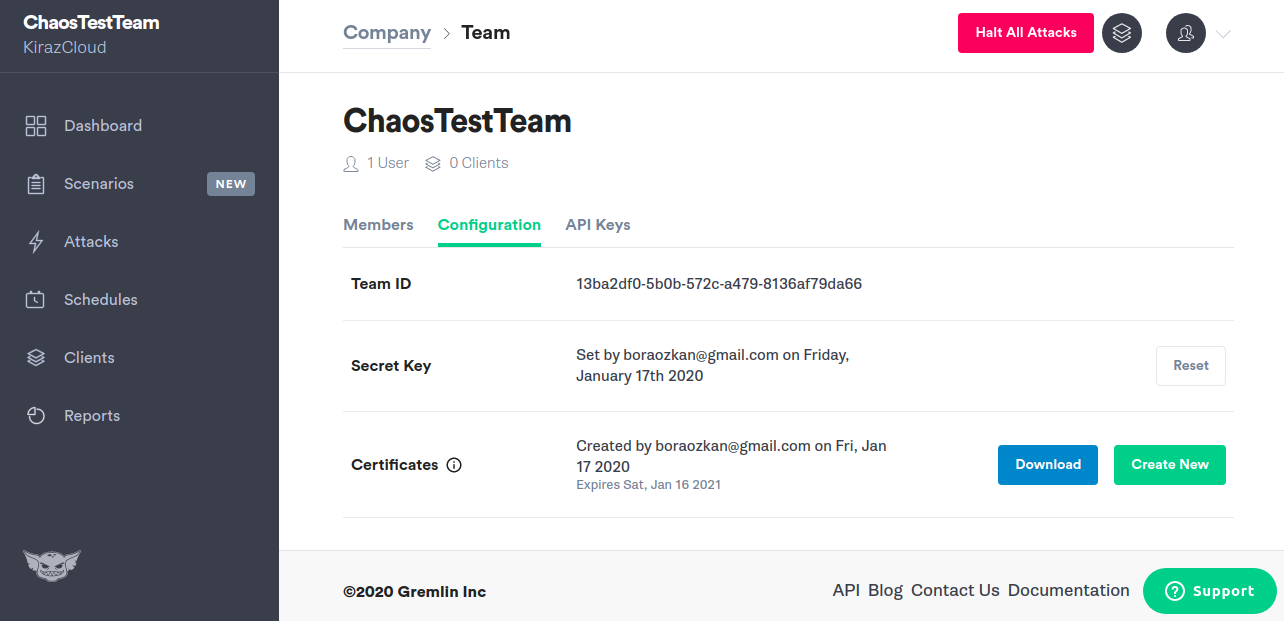
Unzip the certificate.zip and save it to your Gremlin folder on your desktop. Rename your certificate as gremlin.cert and key files as gremlin.key.
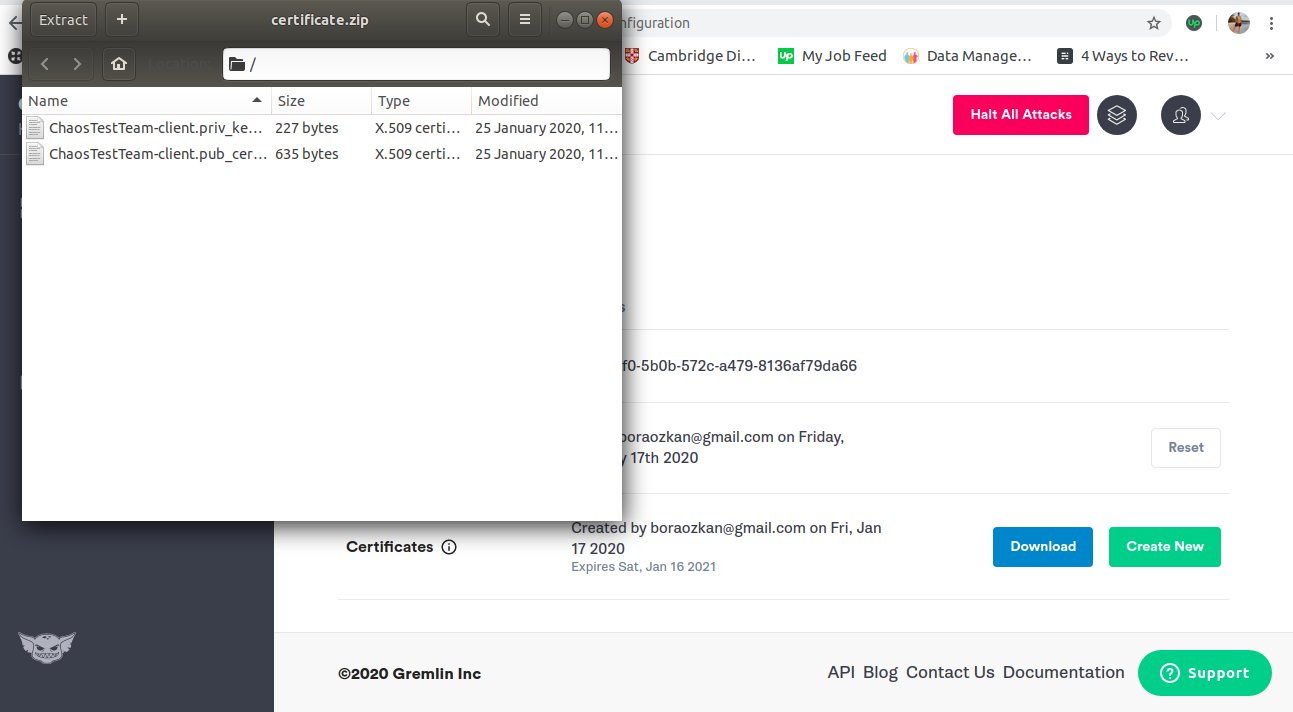

Creating Gremlin Namespace:
xxxxxxxxxx
Administrator:~/environment $ kubectl create namespace gremlin
namespace/gremlin created
Administrator:~/environment $
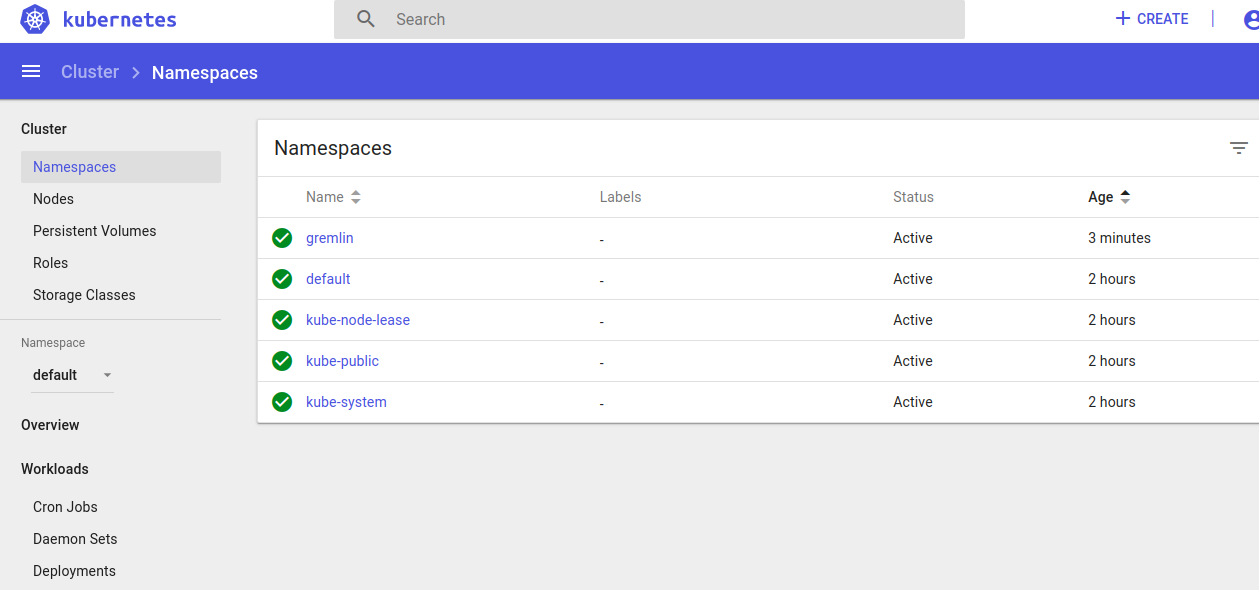
Create a Kubernetes Secret for your certificate and private key, copy gremlin.cert and gremlin.key to Cloud9. A quick tip is to create these by the Vim Editor instead of copying from your local computer.
xxxxxxxxxx
Administrator:~/environment $ kubectl create secret generic gremlin-team-cert \
> \--namespace=gremlin \
> \--from-file=/home/ec2-user/environment/gremlin.cert \
> \--from-file=/home/ec2-user/environment/gremlin.key
secret/gremlin-team-cert created
Administrator:~/environment $
Check the files on Dashboard whether they are deployed.
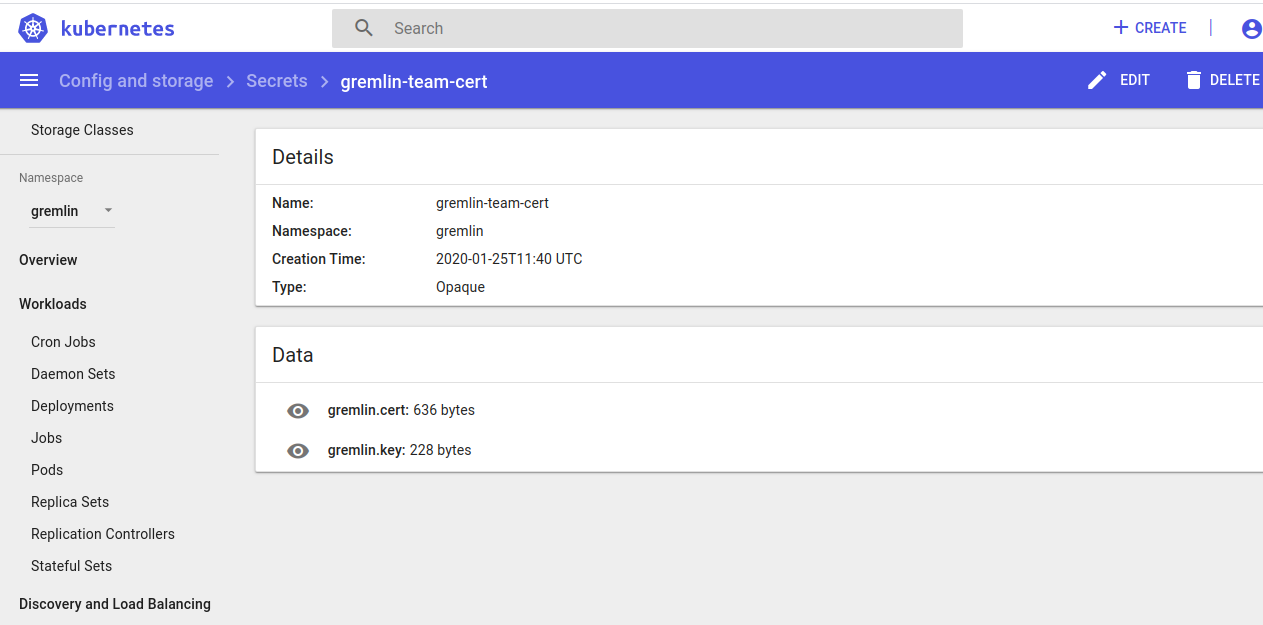
Installation With Helm
The simplest way of installing the Gremlin client on your Kubernetes cluster is to use Helm. Once Helm is installed and configured, the next steps will be to add the Gremlin repo and to install the client.
Installing Helm source code and making it executable:
xxxxxxxxxx
Administrator:~/environment $ curl https://raw.githubusercontent.com/kubernetes/helm/master/scripts/get > get_helm.sh
% Total % Received % Xferd Average Speed Time Time Time Current Dload Upload Total Spent Left Speed
100 7164 100 7164 0 0 45630 0 --:--:-- --:--:-- --:--:-- 45341
Administrator:~/environment $
Administrator:~/environment $ chmod +x get_helm.sh
Administrator:~/environment $
Administrator:~/environment $ ./get_helm.sh
Downloading https://get.helm.sh/helm-v2.16.1-linux-amd64.tar.gz
Preparing to install helm and tiller into /usr/local/bin
helm installed into /usr/local/bin/helm
tiller installed into /usr/local/bin/tiller
Run 'helm init' to configure helm.
Administrator:~/environment $
Configuring Helm to access with RBAC
Helm relies on a service called Tiller which requires special permission on the Kubernetes cluster, for which we will need to build a Service Account for using Tiller. Next step is to then apply this RBAC to the cluster.
Creating a new service account:
xxxxxxxxxx
Administrator:~/environment $ cat < ~/environment/rbac.yaml
> ---
> apiVersion: v1
> kind: ServiceAccount
> metadata:
> name: tiller
> namespace: kube-system
> ---
> apiVersion: rbac.authorization.k8s.io/v1beta1
> kind: ClusterRoleBinding
> metadata:
> name: tiller
> roleRef:
> apiGroup: rbac.authorization.k8s.io
> kind: ClusterRole
> name: cluster-admin
> subjects:
> - kind: ServiceAccount
> name: tiller
> namespace: kube-system
> EoF
Administrator:~/environment $
Applying configurations:
xxxxxxxxxx
Administrator:~/environment $ kubectl apply -f ~/environment/rbac.yaml
serviceaccount/tiller created
clusterrolebinding.rbac.authorization.k8s.io/tiller created
Administrator:~/environment $
Installing Tiller for Helm:
Tiller
A companion server component, tiller, that runs on your Kubernetes cluster, listens for commands from helm, and handles the configuration and deployment of software releases on the cluster.
xxxxxxxxxx
Administrator:~/environment $ helm init --service-account tiller
Creating /home/ec2-user/.helm
Creating /home/ec2-user/.helm/repository
Creating /home/ec2-user/.helm/repository/cache
Creating /home/ec2-user/.helm/repository/local
Creating /home/ec2-user/.helm/plugins
Creating /home/ec2-user/.helm/starters
Creating /home/ec2-user/.helm/cache/archive
Creating /home/ec2-user/.helm/repository/repositories.yaml
Adding stable repo with URL: https://kubernetes-charts.storage.googleapis.com
Adding local repo with URL: http://127.0.0.1:8879/charts
$HELM_HOME has been configured at /home/ec2-user/.helm.
Tiller (the Helm server-side component) has been installed into your Kubernetes Cluster.
Please note: by default, Tiller is deployed with an insecure 'allow unauthenticated users' policy.
To prevent this, run `helm init` with the --tiller-tls-verify flag.
For more information on securing your installation see: https://docs.helm.sh/using_helm/#securing-your-helm-installation
Administrator:~/environment $
This will install tiller into the cluster and will give access to managed resources in your cluster. Please note the security policy alert as shown above, which you can feel free to ignore or follow as per your policy settings.
Activating bash-completion for Helm:
xxxxxxxxxx
Administrator:~/environment $ helm completion bash >> ~/.bash_completion
Administrator:~/environment $ . /etc/profile.d/bash_completion.sh
Administrator:~/environment $ . ~/.bash_completion
Administrator:~/environment $
To run the Helm install, you will need your Gremlin Team ID. It can be found in the Gremlin app on the Team Settings page, where you downloaded your certificates earlier. Click on your Team in the list. The ID you’re looking for can be found under Configuration as Team ID.

Export your Team ID as an environment variable:
xxxxxxxxxx
Administrator:~/environment $ export GREMLIN_TEAM_ID=13ba2df0-5b0b-572c-a479-8136af79da66
Administrator:~/environment $
Next, export your cluster ID, by giving a name for your Kubernetes cluster.
xxxxxxxxxx
Administrator:~/environment $ export GREMLIN_CLUSTER_ID=boraozkanchaos
Administrator:~/environment $
Now add the Gremlin Helm repo, and install Gremlin:
xxxxxxxxxx
Administrator:~/environment $ helm repo add gremlin https://helm.gremlin.com
"gremlin" has been added to your repositories
Administrator:~/environment $
Administrator:~/environment $ helm install gremlin/gremlin \
> \--namespace gremlin \
> \--name gremlin \
> \--set gremlin.teamID=$GREMLIN_TEAM_ID \
> \--set gremlin.clusterID=$GREMLIN_CLUSTER_ID
NAME: gremlin
LAST DEPLOYED: Sat Jan 25 12:37:45 2020
NAMESPACE: gremlin
STATUS: DEPLOYED
RESOURCES:
==> v1/ClusterRole
NAME AGE
gremlin-watcher 0s
==> v1/ClusterRoleBinding
NAME AGE
chao 0s
==> v1/DaemonSet
NAME AGE
gremlin 0s
==> v1/Deployment
NAME AGE
chao 0s
==> v1/Pod(related)
NAME AGE
chao-698b9fbfb4-5thjp 0s
gremlin-425wv 0s
gremlin-krdlt 0s
gremlin-l252z 0s
==> v1/ServiceAccount
NAME AGE
chao 0s
Administrator:~/environment $
Step 5 - Deploying a Microservice Demo Application
The demo environment we are going to deploy on to our EKS cluster is the Hipster Shop: Cloud-Native Microservices Demo Application
Clone repo of app source code:
xxxxxxxxxx
Administrator:~/environment $ git clone https://github.com/GoogleCloudPlatform/microservices-demo.git
Cloning into 'microservices-demo'...
remote: Enumerating objects: 30, done.
remote: Counting objects: 100% (30/30), done.
remote: Compressing objects: 100% (21/21), done.
remote: Total 2987 (delta 16), reused 16 (delta 7), pack-reused 2957
Receiving objects: 100% (2987/2987), 5.08 MiB | 38.24 MiB/s, done.
Resolving deltas: 100% (2039/2039), done.
Administrator:~/environment $
Change directory to the one just created:
xxxxxxxxxx
Administrator:~/environment $ cd microservices-demo/
Administrator:~/environment/microservices-demo (master) $
Deploying the application:
xxxxxxxxxx
Administrator:~/environment/microservices-demo (master) $ kubectl apply -f ./release/kubernetes-manifests.yaml deployment.apps/emailservice created
service/emailservice created
deployment.apps/checkoutservice created
service/checkoutservice created
deployment.apps/recommendationservice created
service/recommendationservice created
deployment.apps/frontend created
service/frontend created
service/frontend-external created
deployment.apps/paymentservice created
service/paymentservice created
deployment.apps/productcatalogservice created
service/productcatalogservice created
deployment.apps/cartservice created
service/cartservice created
deployment.apps/loadgenerator created
deployment.apps/currencyservice created
service/currencyservice created
deployment.apps/shippingservice created
service/shippingservice created
deployment.apps/redis-cart created
service/redis-cart created
deployment.apps/adservice created
service/adservice created
Administrator:~/environment/microservices-demo (master) $
Wait until pods are in a ready state.
xxxxxxxxxx
Administrator:~/environment/microservices-demo (master) $ kubectl get pods
NAME READY STATUS RESTARTS AGE
adservice-84449b8756-qj4sp 1/1 Running 0 4m57s
cartservice-6cbc9b899c-ww5rf 1/1 Running 0 4m58s
checkoutservice-56b48b77c8-fszpx 1/1 Running 0 4m58s
currencyservice-b9fcb4c98-hx9kq 1/1 Running 0 4m58s
emailservice-797cdcc76d-d257v 1/1 Running 0 4m58s
frontend-785c44fd98-zvgj4 1/1 Running 0 4m58s
loadgenerator-665c4ddb74-xwm8m 1/1 Running 3 4m58s
paymentservice-84d7bf956-fdgxr 1/1 Running 0 4m58s
productcatalogservice-5664f59f54-b5mk5 1/1 Running 0 4m58s
recommendationservice-7f9855d7c6-b2zv6 1/1 Running 0 4m58s
redis-cart-6448dcbdcc-97d55 1/1 Running 0 4m58s
shippingservice-6b6f49747d-svb5f 1/1 Running 0 4m58s
Administrator:~/environment/microservices-demo (master) $
Getting the frontend IP address:
xxxxxxxxxx
Administrator:~/environment/microservices-demo (master) $ kubectl get svc frontend-external -o wide
NAME TYPE CLUSTER-IP EXTERNAL-IP PORT(S) AGE SELECTOR
frontend-external LoadBalancer 10.100.226.157 a0c9bed9a3f7111eab7c912c03cd100e-265884000.us-east-1.elb.amazonaws.com 80:30461/TCP 6m31s app=frontend
Administrator:~/environment/microservices-demo (master) $
Visit the URL on your browser:

Step 6 - Running a Shutdown Container Attack using Gremlin
We are going to create our first Chaos Engineering experiment where we would validate the EKS reliability. Our hypothesis is, “After shutting down my cart service container, we will not suffer from downtime and EKS will give us a new one.”
Going back to the Gremlin UI, select Attacks from the menu on the left and select New Attack. We’re going to target a Kubernetes resource, so click on Kubernetes on the upper right.
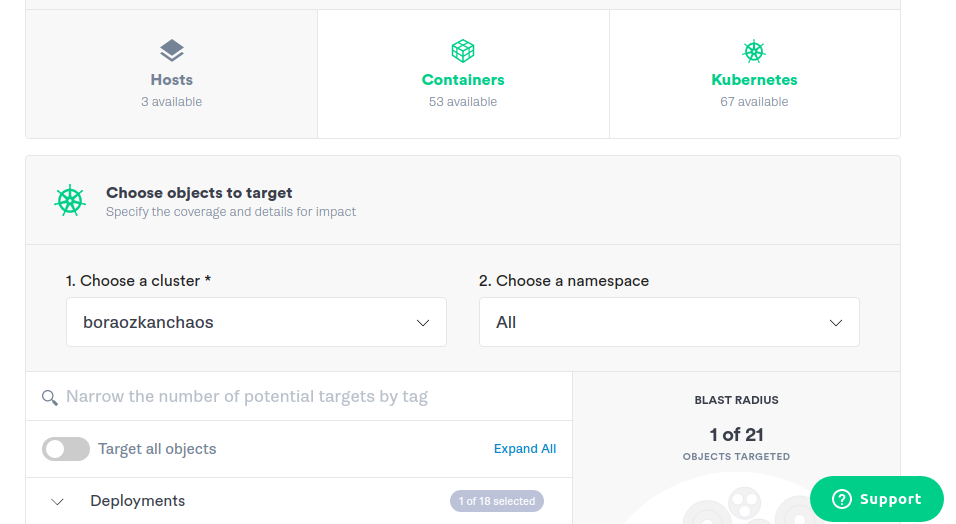
Choose cartservice:
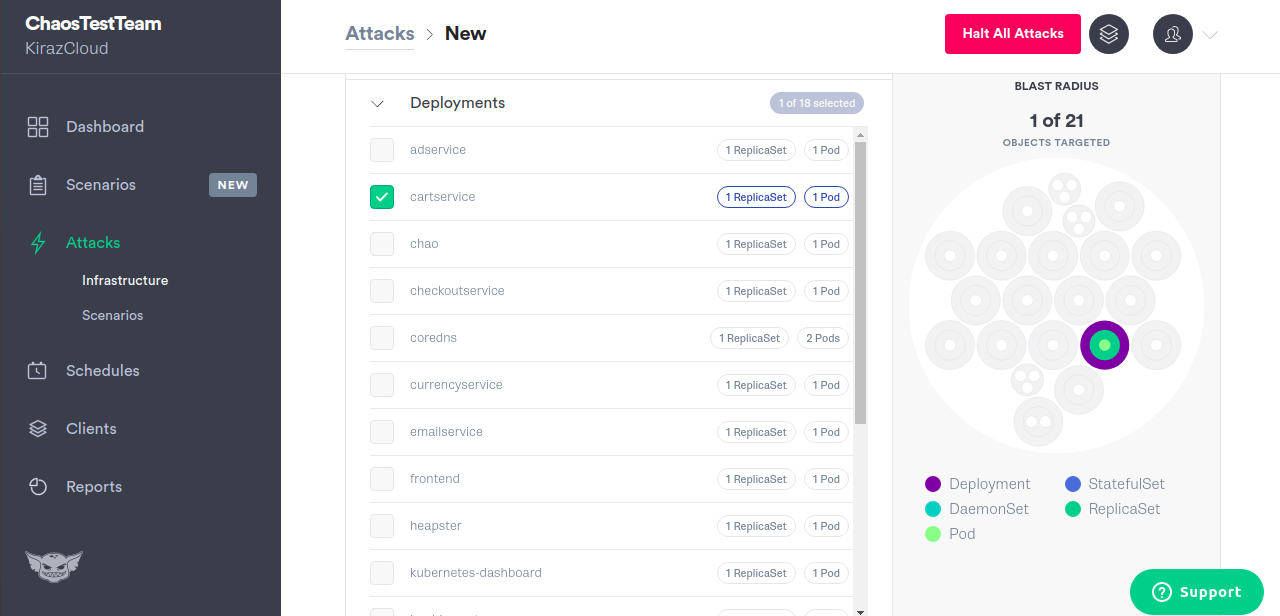
Choose State and Shutdown:
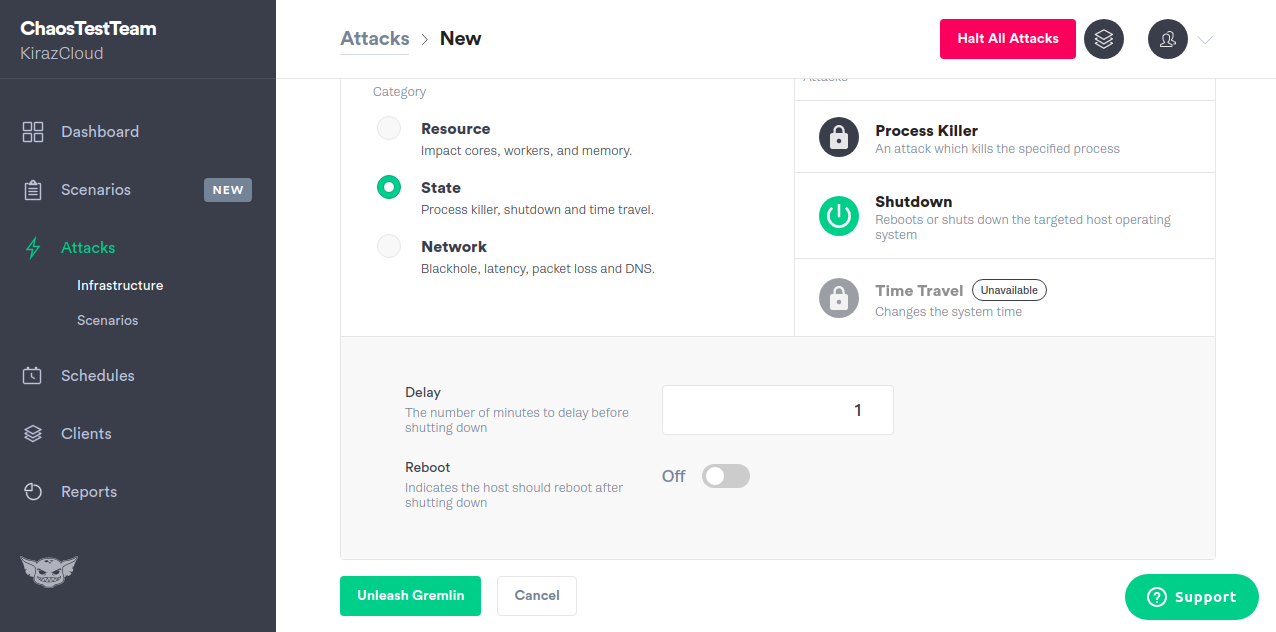
Attacking this pod with our Gremlin UI:
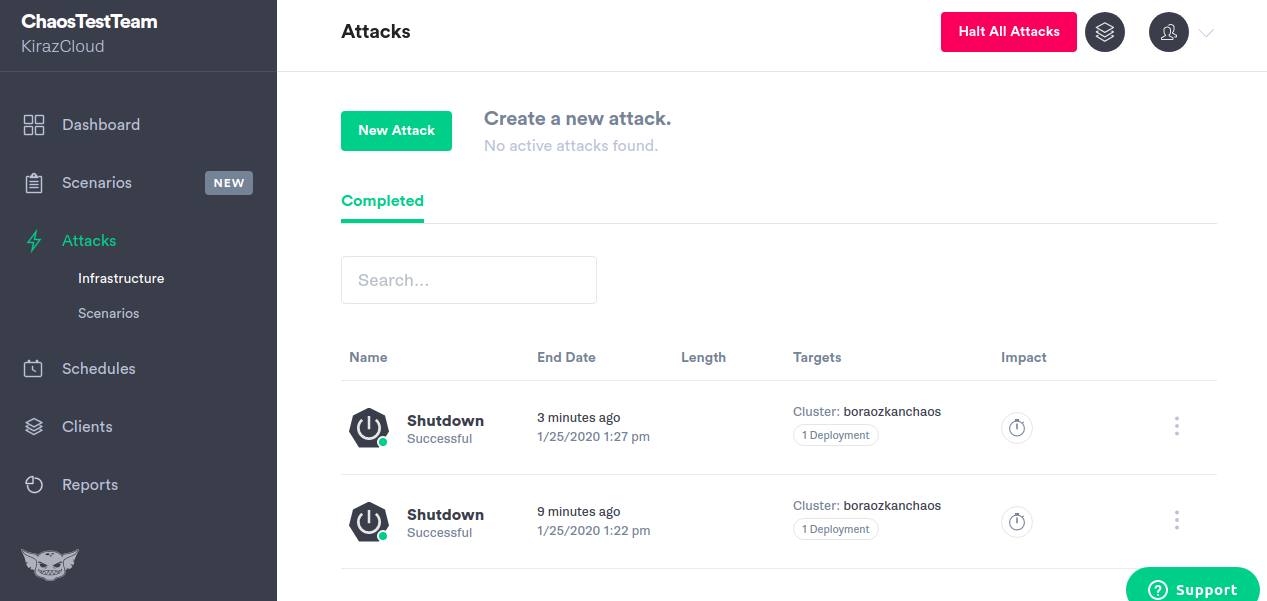
We will be shutting down the cartservice containers. As a test, we attacked twice and the cartservice pods restarted itself. Which signifies that it is working as expected. Note that it re-generates itself even when you attack to shut down your pods.
When we attacked our containers, the cluster resisted to failure and restarted itself, which symbolizes that our system is now resistant to failure. We have seen what happens when a failure occurs, in this example the failure is shutting down the pods. As a result, we understand that our cluster already has auto-scaling feature.

As a reminder; do not forget to delete your cluster and Cloud9 ide.
eksctl delete cluster --name=gremlin-eksctl
Conclusion
Congrats! You’ve installed an AWS EKS cluster, deployed the Kubernetes Dashboard, deployed a microservice demo application, installed the Gremlin agent as a daemon-set, and ran your first Chaos Engineering attack to validate Kubernetes reliability!
Published at DZone with permission of Sudip Sengupta. See the original article here.
Opinions expressed by DZone contributors are their own.

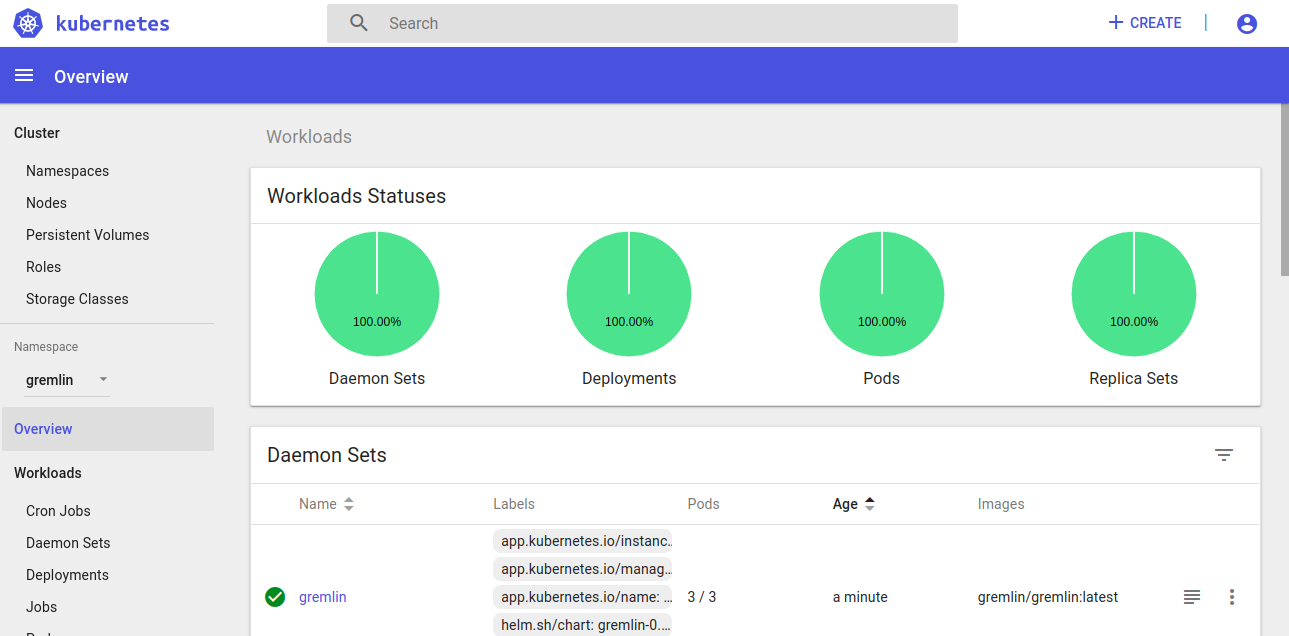
Comments